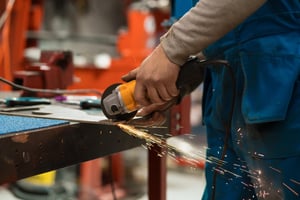Material Handling Equipment [MHE] includes a wide range of tools, machinery and vehicles which are...
Knuckle Thrower: Understanding this Manufacturing Process
In the intricate manufacturing process, countless techniques transform raw materials into the products that we use daily. And among those one fascinating and specialized process is there that helps in making the whole thing convenient is knuckle throwing. While it may sound like a term from a martial arts manual, in manufacturing, the method refers to a precise and intricate technique that knuckle thrower manufacturers use to shape and form materials, particularly metals.
However, people still have less knowledge about the manufacturing process. So, for that, we are here with this blog where everyone gets to understand the whole process. With this, let’s understand what are the basics of knuckle-throwing.
Basics of Knuckle Throwing
This is the process that is associated with the forming & forging process, which involves manipulating metal into a desired shape using a combination of force, heat, and intricate tooling. The term "knuckle" in this context refers to the knuckle joints, which are pivotal in the movement and force application within the machinery used for this process.
This is the technique that is widely used in the production of parts that require complex geometries and high strength, such as automotive components, aerospace parts, and various industrial machinery.
Now, let’s have a look at the thing that which kind of mechanics knuckle throwing has for everyone. Let’s know about that:
The Mechanics of Knuckle Throwing
The knuckle-throwing process when it comes to mechanics typically involves the following steps, like:
The process begins with the selection of appropriate materials that mainly maintain their properties after being shaped. Common materials include steel, aluminum, and titanium alloys.
To make the metal more pliable, it is heated to a specific temperature. This step is crucial as it reduces the risk of cracking or breaking during the forming process.
Specialized tools, often referred to as dies, are designed to match the desired shape of the final product. These tools are mounted on the machinery, ready to apply the necessary force.
The heated metal is placed between the dies, and force is applied using mechanical or hydraulic presses. The knuckle joints in the machinery allow for precise control of the movement and force application, ensuring the metal is shaped accurately.
Cooling and Finishing: After the metal is formed, it is cooled down to solidify its new shape. Additional finishing processes, such as machining or surface treatment, may be applied to achieve the desired surface quality and dimensional accuracy.
Applications for Throwing Knuckles
Many industries rely on knuckle-throwing because it can create robust, intricate parts that are advantageous to them all. Here are a couple of noteworthy uses:
Automotive Sector: Parts such as crankshafts, connecting rods, and suspension components are made in the car industry by knuckle-throwing. For the safety and functionality of the vehicle, these parts must withstand extreme strains and retain exact measurements.
Aerospace Industry: The aerospace industry uses knuckle-throwing a lot to make parts including landing gear, structural pieces, and turbine blades. Because every ounce counts in the aerospace sector, the technique's ability to produce parts that are both strong and lightweight is essential.
Heavy Machinery: Gears, axles, and hydraulic components are produced by knuckle throwing in industries that depend on heavy machinery, like mining and construction. To survive challenging operating circumstances, these components need to be sturdy and dependable.
Medical Devices: The medical sector gains from knuckle-throwing as well, especially in the manufacturing of implants and surgical tools. For medical procedures to be performed effectively and with patient safety, these components must be strong and precise.
Difficulties and Things to Think About
Although there are several advantages to knuckle-throwing, producers also need to consider the following issues:
Tooling Expenses: It can be costly to design and produce specialty dies. The process's long-term advantages must be weighed against the initial tooling expenses for manufacturers.
Technical Know-How: A considerable degree of technical proficiency is necessary for successful knuckle-throwing. Expert engineers and operators are necessary to guarantee that the procedure is carried out accurately and reliably.
Ensuring that the final products satisfy the necessary requirements requires tight quality control, which must be maintained throughout the process. This calls for routine testing and inspection of the components as well as the final goods.
In Summary
The detail gives the idea of what actually everyone should know to understand the manufacturing process of knuckle throwers. Apart from this, if you have any other queries then feel free to raise them anytime as we are always here to rectify your problems.
Also Read: How to Find the Best Sheet Metal Components and Parts Manufacturers in India


